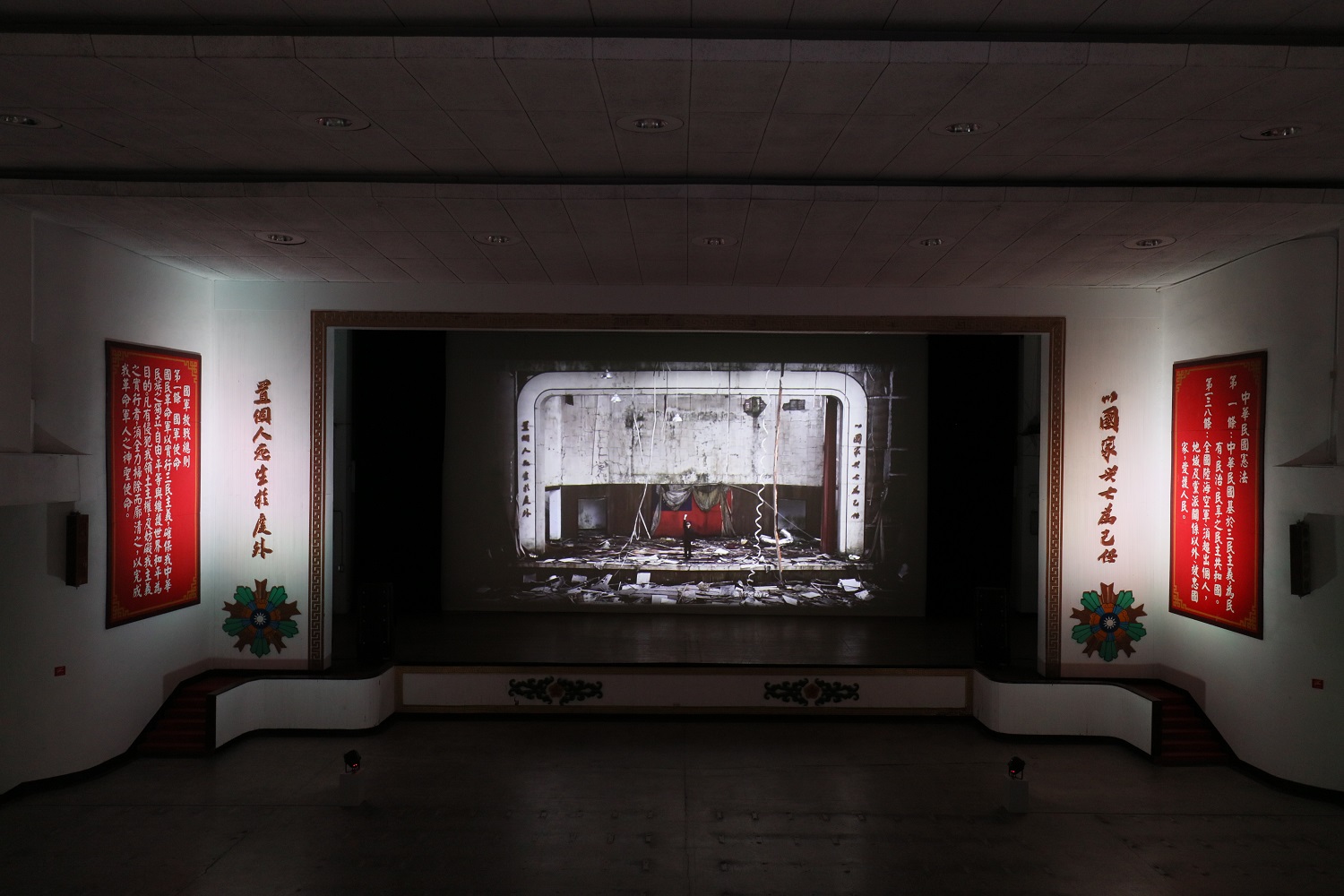原來,「犬儒共和國」是姚瑞中2008年發想,卻始終未能實現的創作計畫。在這個計畫裡,犬儒與魔鬼是國家的靈魂人物,弔詭的是,對思想、教條、風俗理應抱持懷疑的犬儒,卻和擁有超自然力量又滿腔敗德欲望的魔鬼攜手「建國」,如連體嬰般屁股相連的兩人構成國徽圖像,更誕下全身鍍金、頭上長角的後代「金寶娃」,繼續擾亂世界。1
「犬儒」一詞源於古希臘時期的「犬儒學派」(Cynicism),這群藐視權威、質疑教條、鄙視金錢物質的哲人,藉由誇大的日常行為和言詞辯證,撕開世俗的虛偽假面,態度激進。然而,隨著時空更迭,犬儒內涵也產生變異;當代社會的犬儒有著憤世嫉俗、玩世不恭的面貌,甚至百般嘲弄他人認可的正向價值。姚瑞中在創作「犬儒外史」系列(2004)、「犬儒共和國」系列(2006)時讓犬儒入題,透過犬儒式的戲謔與嘲弄,回應臺灣政治的荒謬百態2,同時也指稱當代犬儒為了自身利益,能與魔鬼達成協議,水乳交融又各懷鬼胎,如這次「犬儒共和國」個展,姚瑞中更藉以影射中華民國(兩國縮寫都是R.O.C.),同時也喻指其他曾被殖民的小國,得和魔鬼般的強權國家進行各種交易,方能爭取生存空間的國際現實;因此,犬儒/小國與魔鬼/強國間是彼此牽動的共生關係。
從這樣的角度解讀C-LAB委託創作的「犬儒共和國」系列錄像新作,就不難理解姚瑞中的創作思路,以及何以選擇美援大樓為主展場。四件錄像新作題材取自:1969年美國登陸月球、1979年美國與中國建交、1989年天安門「六四事件」、2001年美國「911事件」,姚瑞中以「姚式style」重新詮釋這四則重大的歷史切片。
 姚瑞中,《犬儒共和國:1979》,2020。圖©臺灣當代文化實驗場
姚瑞中,《犬儒共和國:1979》,2020。圖©臺灣當代文化實驗場
1969年,美國太空人在月球插上星條旗的影像,不僅記錄人類登月的重要時刻,也強化美國是世界強權的國際地位。姚瑞中假南臺灣的「月世界」拍攝《犬儒共和國:1969》,他扮演的太空人在高爾夫球入洞之後,將美國國旗拔起丟飛,換上犬儒共和國國旗,宣示月球「易主」。冷戰時期,以美、蘇為首的資本和共產主義陣營各有擁護國,然而,1979年美國與中華人民共和國建交,等同承認中共才是代表中國的統治政權,《犬儒共和國:1979》喚起兩國建交前夕,美國先宣布與中華民國斷交,全臺掀起大規模反美示威的歷史記憶。只不過,片中捍衛「犬儒共和國大使館」的警察,反倒像是健美先生巧扮的一個角色,在500顆蛋襲之下,健美先生完成比賽制式的動作流程,臺灣的歷史創傷則是在飛濺的蛋液與壯碩的男體肌肉交融下,飄出一股情色氣味。
《犬儒共和國:1989》再現「六四事件」中,一名男子以肉身阻擋坦克車隊前進的經典畫面,這名男子被稱為「坦克人」。姚瑞中從中國訂購四部誘敵用的充氣坦克作為道具,在C-LAB廣場打造相似場景進行拍攝,個展期間,這四部充氣未滿的坦克也在廣場展示——沒有「六四」當時的肅殺氛圍,坦克軟癱的模樣猶如徒具外表的紙老虎。畫面同樣震懾人心的「911事件」,堪稱當代最具代表性的災難影像,全世界因而籠罩在恐怖攻擊的恐懼當中,《犬儒共和國:2001》片中一名全副武裝的蒙面男子,套上特製的蜂炮衣走進「犬儒共和國警察局」,引燃身上的火藥四射猶如花火秀,不見恐攻的暴力成分,只像華麗的電影特效。
美援大樓同步展出與「犬儒共和國」個展概念一脈相承的舊作,窺見犬儒與魔鬼圖像發展的源流,像是約自1994年開始發展的「螺旋槳人」圖像、《反攻大陸行動:入伍篇之菊花寶典》(1994-1996),學犬隻撒尿畫地盤的《本土佔領行動》(1994),諷刺被消費主義物化的「人下人」系列(2001),「犬儒外史」系列(2004)及「犬儒共和國」系列(2006)等。除此之外,姚瑞中在國立藝術學院(今國立臺北藝術大學)就讀期間創辦的《宣統報》,與結合校內戲劇、舞蹈、音樂、美術同儕一起創設的「天打那實驗體劇團」等檔案資料,也於這次一併展陳,梳理其創作紋脈。
美援大樓於1950年代美援時期所建,當時中華民國空軍裝備大多來自美國,美軍顧問團也曾進駐空總,因此,以鋼筋混凝土和空心磚建造的美援大樓可謂歷史的見證。2012年空軍總司令部撤離之後,美援大樓處於閒置狀態,去年底初步整修並於本展首度開放,作為「犬儒共和國駐中華民國大使館」卻呈廢墟狀,也隱喻R.O.C.(中華民國)的外交困境。
有趣的是,姚瑞中(1969年生)1994年入伍,就是在空軍政戰室服兵役,負責思想教育和康樂事務3,不僅個人的生命經驗與創作疊合,也與本次在空總舉辦個展有著因緣上的巧合。
 姚瑞中以「中華民國史蹟館」作為概念規劃的中正堂展場一景。圖/姚瑞中攝影
姚瑞中以「中華民國史蹟館」作為概念規劃的中正堂展場一景。圖/姚瑞中攝影
1990年代,年方廿多的姚瑞中以《本土佔領行動》(1994)、「反攻大陸行動」系列(1994-1996)鵲起藝壇,這些創作於入伍前後的作品,一方面呼應臺灣五、六年級生的集體記憶:經歷黨國教育、政治解嚴和威權解構的年代;另一方面,在不同的時代,對於政治與歷史各有其詮釋論述方式。於是,當從小被灌輸的「反攻大陸」變成真的口號,個人的思想體系逐漸被瓦解,歷史的真相讓人如陷迷霧,斷裂、失重、失憶與冷漠,成了世代的特質。從早期的「螺旋槳人」圖像到「反攻大陸行動」系列、《玉山飄浮》等政治藝術作品,姚瑞中除了嘲弄威權教育的荒謬,也藉由飄浮的身體喻指思想的虛浮和歷史的斷裂。上述作品這次也在「中正堂」展出。
中正堂原是集會禮堂,內部仍保留當年的愛國口號標語,姚瑞中以「中華民國史蹟館」的概念規劃之,憑弔這個不存在於世界的幽靈政體。他在中正堂展示個人服兵役時期的文件,像是:入伍資料、表現良好的嘉獎紀錄,軍中管控思想的《革命軍》、〈國統綱領〉等文宣品,喚起黨國教育管控人民思想的集體記憶;另展出藝術作品:《反攻大陸行動:行動篇》、《玉山飄浮》、《歷史幽魂》、《分列式》、《萬歲》、《萬萬歲》等影像創作。透過私文件的展陳,佐證個人生命史如何與臺灣政治的演替疊合,也可窺見姚瑞中如何將這段經驗轉化成創作的素材,回應臺灣歷史與政治的荒謬,一如《萬歲》錄像中,姚瑞中扮演的軍隊指揮官,在空無一人的廢棄營區振臂疾呼「萬歲」,帝制的口號彷彿召喚著揮之不去的黨國幽靈,而今卻也只是在中正堂孤聲裊裊地迴盪。
無論是《本土佔領行動》裸體撒尿的快拍快閃,或在「犬儒外史」系列以性事比喻強權與弱國不對等的國際關係,抑或至「犬儒共和國」錄像新作撩撥政治議題的敏感帶,姚瑞中維持一貫冷眼、嘲弄、揶揄和戲謔的姚式風格。時間如急行的火車,歷史迷霧尚未散去,人們又被拋往龐大的數位帝國載浮載沉,真實、真相的探究已非要事,犬儒、酸民才是政治正確的姿態。既然人們無法逃離歷史的荒誕烙印,加入「犬儒共和國」撩撩世間事又何妨!